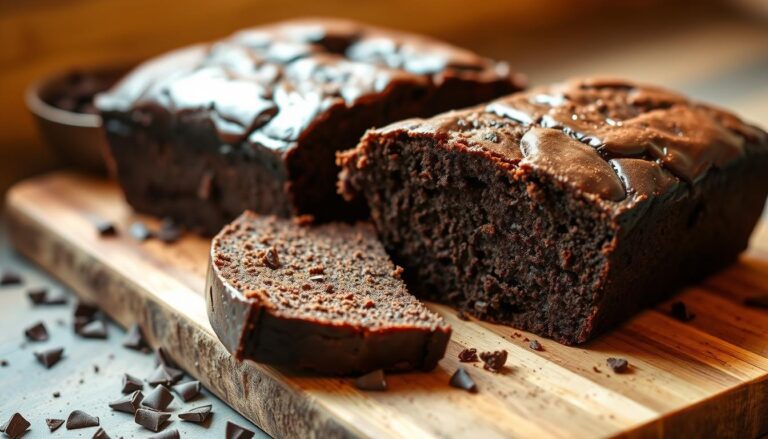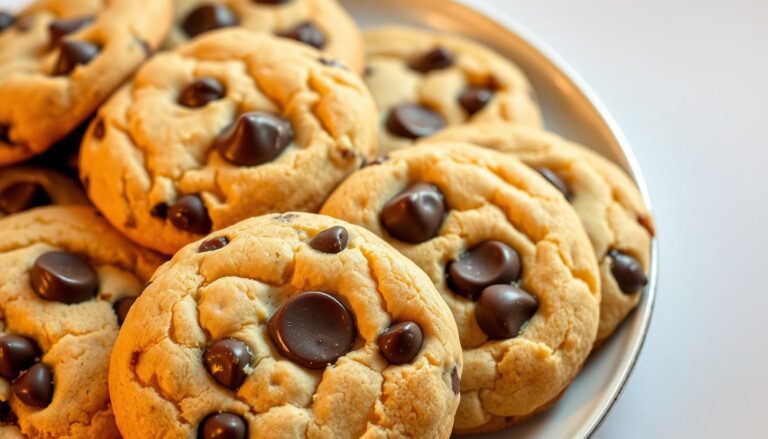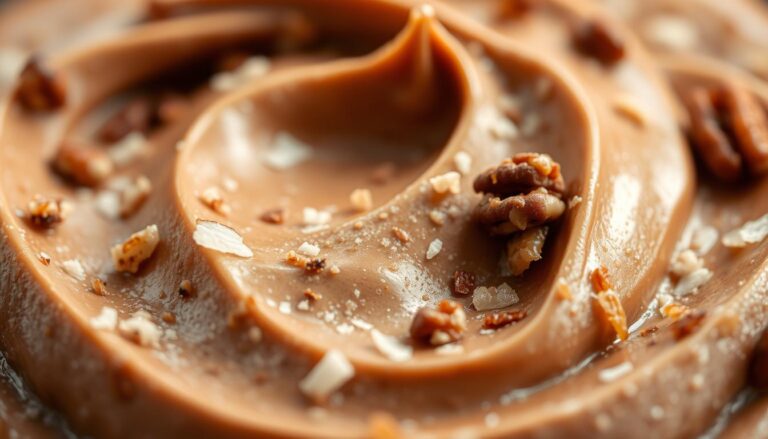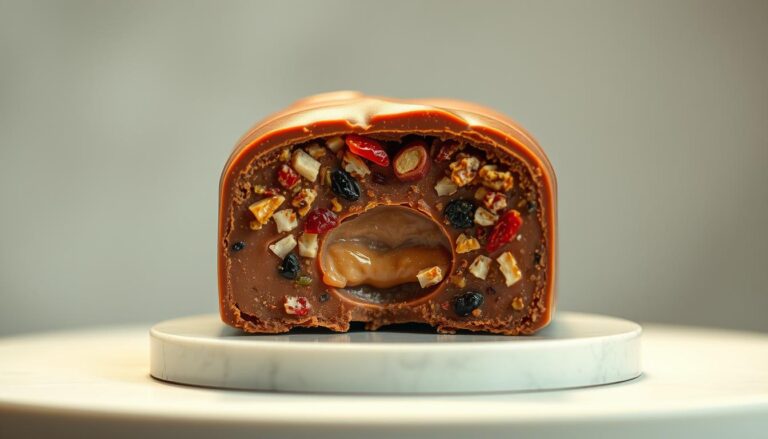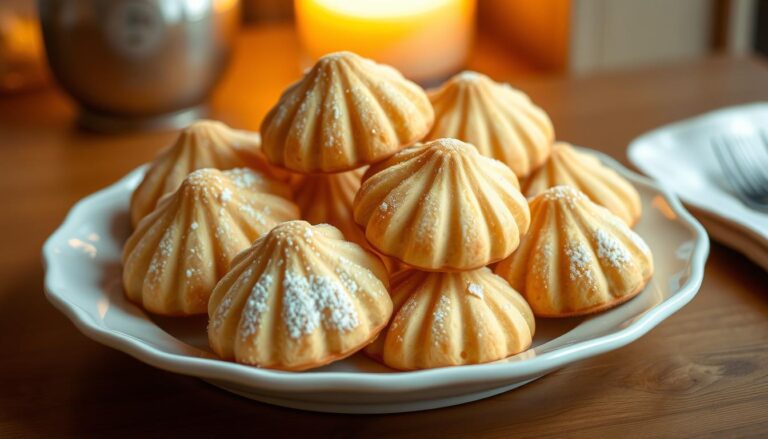German Chocolate Frosting: Ultimate Perfect Recipe
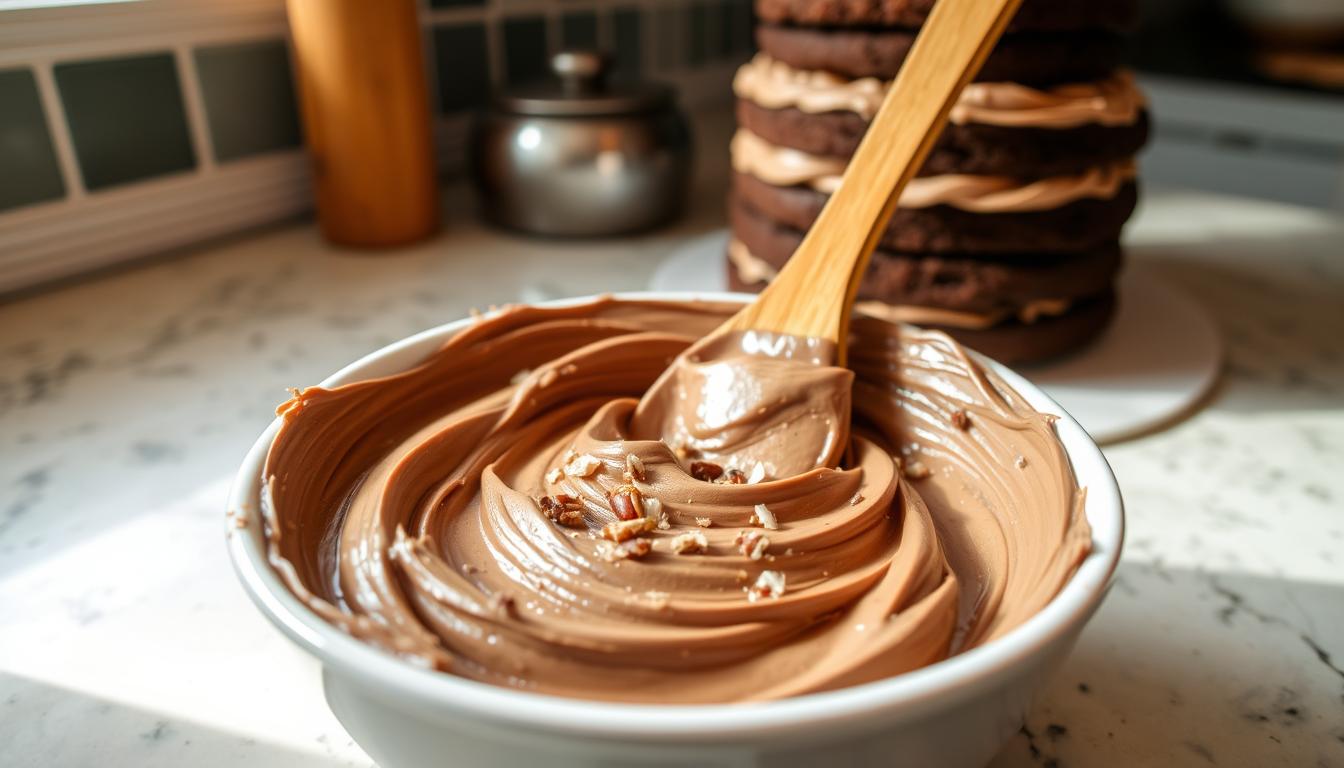
Every family has a special dessert that brings back memories. For me, homemade German chocolate frosting was more than a topping. It was a link to summer gatherings and my grandmother’s kitchen. The frosting’s rich, caramel-like texture and toasted pecan crunch took me back to those warm afternoons.
German chocolate frosting is more than a recipe. It’s a tradition loved by many in the Southern United States. This frosting turns an ordinary cake into a showstopper, symbolizing comfort and classic baking.
Whether you’re an experienced baker or just starting, making homemade German chocolate frosting is a journey. This guide will show you how to make a frosting that will make your desserts unforgettable.
Table of Contents
Key Takeaways
- Learn the authentic technique for German chocolate frosting
- Understand the rich cultural history behind this classic dessert
- Master the art of creating a creamy, decadent frosting
- Discover professional tips for perfect texture and consistency
- Explore the versatility of this beloved Southern dessert topping
Understanding the Origins of German Chocolate Frosting
The story of German chocolate frosting is more interesting than its name. It’s not from Germany, but has deep roots in American cooking. Its origin is a tale of culinary creativity.
The Texas-Born Dessert Legacy
German chocolate frosting started in Texas. It was named after Samuel German, who worked at Baker’s Chocolate Company. In 1852, German made a special dark chocolate that became the base for this famous frosting.
- Invented in the mid-19th century
- Named after Samuel German, not the country
- Created with a unique baking chocolate blend
Evolution of the Classic Recipe
The frosting evolved from a simple recipe to a Southern favorite. Its creamy texture and mix of coconut and pecans made it loved across the U.S.
Why This Frosting Became a Southern Staple
Southern bakers loved it for its rich taste and flexibility. The mix of caramelized pecans and sweet coconut made it a hit. Its tasty history and flavor made it a staple in Southern cooking.
A true testament to American culinary creativity, German chocolate frosting represents more than just a dessert topping—it’s a piece of cultural heritage.
Essential Ingredients for Perfect German Chocolate Frosting
Making an easy German chocolate frosting recipe begins with top-notch ingredients. These ingredients are what make the frosting rich and delicious. Choosing the right ones is crucial for a great frosting.
The main ingredients for a true German chocolate frosting are:
- Evaporated milk – gives it a creamy feel
- Egg yolks – make it smooth and luxurious
- Brown sugar – adds a deep caramel taste
- Unsalted butter – keeps it smooth
- Vanilla extract – boosts the flavor
- Sweetened shredded coconut – the classic topping
- Chopped pecans – add a nice crunch
When picking ingredients for your frosting, go for the freshest and highest quality. Organic eggs, real vanilla extract, and fresh nuts make a big difference. They can turn your frosting into something truly special.
Pro tip: Room temperature ingredients blend more smoothly and create a more consistent frosting texture.
Every ingredient is important for the frosting’s unique taste and feel. Getting the right amounts and choosing quality ingredients is essential. This way, you’ll get that classic Southern dessert taste everyone loves.
The Role of Brown Butter in Enhanced Flavor
Brown butter, or beurre noisette, is a secret ingredient that makes your German chocolate frosting amazing. It involves heating butter slowly to get a rich, nutty taste. This makes the dessert taste even better.
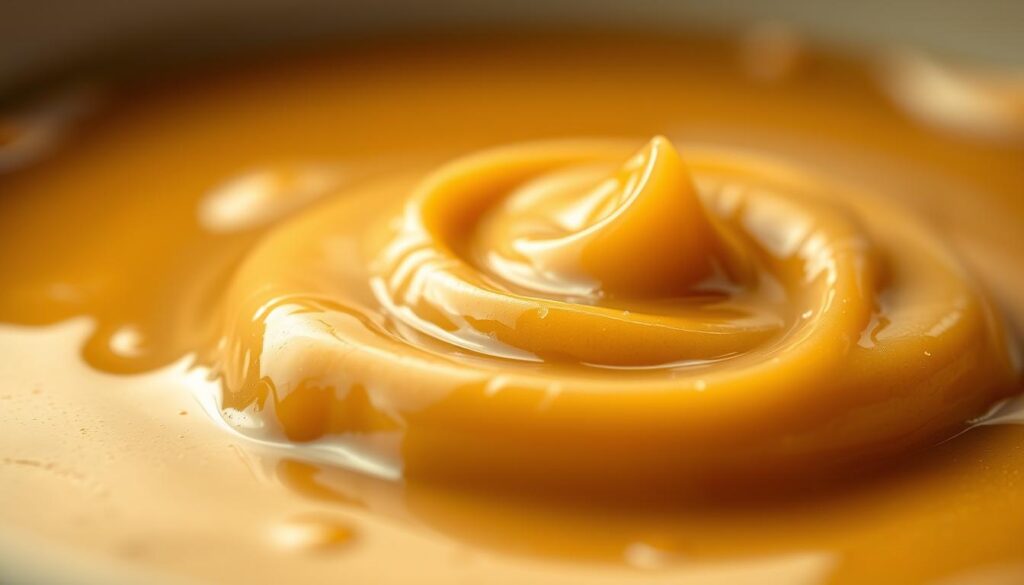
What is Beurre Noisette
Beurre noisette means “hazelnut butter” in French. It gets its nutty smell and golden color when butter is heated slowly. This trick adds depth to your German chocolate frosting.
How to Achieve the Perfect Brown Butter
- Use unsalted butter cut into uniform pieces
- Select a light-colored saucepan for easy color monitoring
- Melt butter over medium heat
- Stir continuously to prevent burning
- Watch for golden brown color and nutty aroma
Different Stages of Browning
| Stage | Description | Duration |
|---|---|---|
| Melting | Butter begins to foam, water evaporates | 3-5 minutes |
| Foaming | Foam rises, butter starts to simmer | 2-3 minutes |
| Browning | Milk solids turn golden brown | 5-7 minutes |
Getting good at making brown butter takes time, but it’s worth it. It makes your German chocolate frosting stand out. Take the butter off the heat as soon as it’s deep golden to avoid burning.
Step-by-Step German Chocolate Frosting Preparation
Making german chocolate frosting from scratch needs care and time. It turns simple cakes into amazing desserts. Here’s how to make this tasty frosting.
First, get these key ingredients:
- 1 cup evaporated milk
- 1 cup granulated sugar
- 3/4 cup unsalted butter
- 3 large egg yolks
- 1 teaspoon vanilla extract
- 1 1/3 cups sweetened shredded coconut
- 1 cup chopped pecans
Perfect german chocolate frosting comes from careful cooking. Start by mixing evaporated milk, sugar, butter, and egg yolks in a saucepan. Stir constantly to avoid lumps and get a smooth frosting.
| Cooking Stage | Duration | Desired Outcome |
|---|---|---|
| Initial Heating | 3-4 minutes | Ingredients fully combine |
| Thickening Process | 7-10 minutes | Pudding-like consistency |
| Final Mixing | 2-3 minutes | Incorporate coconut and pecans |
Cook until it’s thick like pudding, about 10 minutes. Then, add vanilla, coconut, and pecans. Let it cool before using on your cake.
Tip: For the best frosting, beat egg yolks well and sift coconut. This makes the frosting silky and rich, enhancing your dessert.
Mastering the Proper Temperature Techniques
Making the perfect creamy German chocolate frosting needs precision and careful temperature control. It’s all about understanding how heat changes your ingredients into a smooth, rich topping.
Temperature is key to getting the frosting’s rich flavor and silky texture. Professional bakers know that small temperature changes can make a big difference.
Digital Thermometer: Your Precision Tool
Getting a high-quality digital thermometer is crucial for making great creamy German chocolate frosting. These tools give you instant, accurate readings. They help you:
- Keep track of exact cooking temperatures
- Avoid scorching or undercooking
- Get consistent results every time
Critical Temperature Points
For the best creamy German chocolate frosting, aim for these temperature ranges:
- 185-195°F: The perfect thickening zone
- 200°F: Risk of burning ingredients
- 170°F: Potential underdevelopment of flavors
Avoiding Common Temperature Mistakes
Stay away from these temperature-related mistakes to avoid texture issues:
- Inconsistent heat can cause a grainy texture
- Overheating breaks down sugar structures
- Uneven cooking results in separated frosting
Mastering temperature control makes your German chocolate frosting go from good to extraordinary. It ensures a creamy and delicious result every time.
Tips for Achieving the Perfect Consistency
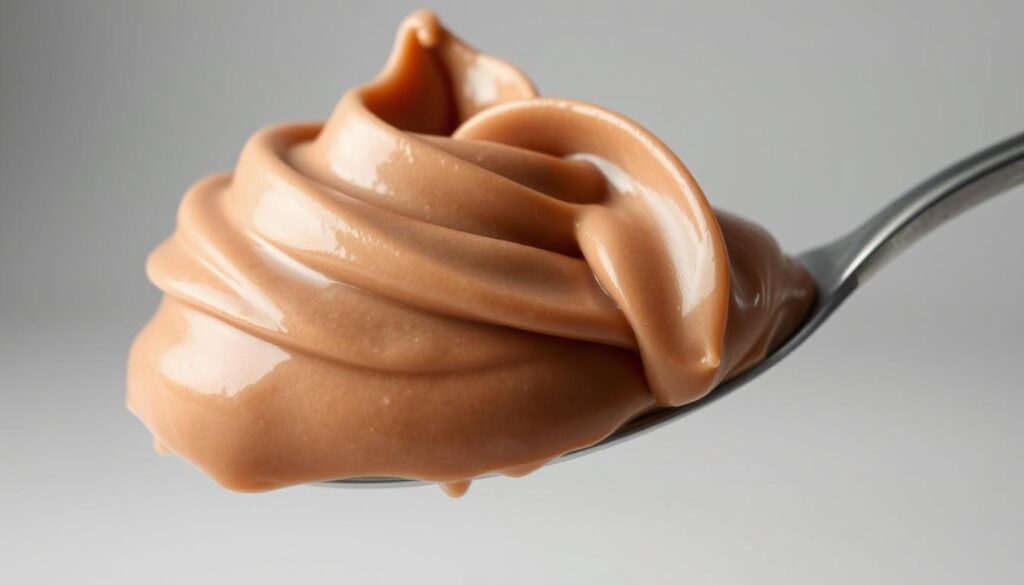
Making the perfect easy German chocolate frosting recipe needs precision and attention to detail. The right consistency is key for a great dessert. Your frosting should be thick enough to hold its shape but still smooth and easy to spread.
Several factors affect the frosting’s consistency:
- Cooking time for the egg yolk mixture
- Precise ingredient ratios
- Temperature control during preparation
- Proper mixing techniques
When making your easy German chocolate frosting recipe, watch for these important signs:
- Thickness Test: The frosting should coat the back of a spoon without immediately running off
- Texture Check: Look for a smooth, creamy appearance without graininess
- Spreading Ability: Ensure the frosting can be easily spread but maintains its shape
To avoid common consistency issues, pay close attention while cooking. If your frosting is too runny, cook it a bit longer to thicken it. If it’s too thick, gently reheat it and add a little evaporated milk to get the perfect texture.
Pro tip: Evenly distribute shredded coconut and chopped pecans throughout the frosting. This will make your German chocolate cake truly memorable.
Coconut and Pecan Selection and Preparation
Making a real german chocolate cake with frosting needs careful picking and getting ready of coconut and pecans. These two ingredients turn simple frosting into a rich, textured treat. It’s what makes the classic southern dessert so special.
The start of a great german chocolate cake with frosting is picking the right ingredients. Your choice of coconut and pecans is key to the cake’s success.
Choosing the Right Coconut Type
For the best taste, pick sweetened shredded coconut. It gives the cake its chewy texture and sweet taste, just like the traditional version.
- Use only sweetened shredded coconut
- Make sure the coconut is fresh and dry
- Toast the coconut lightly to bring out its sweetness
Toasting Pecans for Enhanced Flavor
Toasting pecans makes their flavor richer and improves the frosting’s taste. You can toast them in two ways:
- Sauté pan method: Low heat, stir constantly
- Oven method: Spread on a baking sheet at 350°F for 8-10 minutes
Proper Nut Chopping Techniques
Chopping pecans finely helps them mix well into the frosting. Use a sharp knife and chop on a stable surface. Go for small, even pieces that mix well with the cake.
Pro tip: Let toasted pecans cool completely before chopping. This stops them from clumping and keeps them crunchy.
Storage and Make-Ahead Guidelines
Preparing homemade German chocolate frosting ahead of time can save you a lot of stress. It’s important to store it right to keep its taste and texture perfect.
There are a few ways to keep your frosting fresh. Here are the top methods to keep your frosting delicious:
- Refrigerator Storage: Keep your frosting in an airtight container
- Freeze for Long-Term Preservation
- Use Proper Sealing Techniques
Here are the storage tips for your homemade German chocolate frosting:
| Storage Method | Duration | Recommended Technique |
|---|---|---|
| Refrigerator | Up to 5 days | Use sealed glass or plastic container |
| Freezer | 2-3 months | Wrap tightly in plastic wrap and freezer bag |
When you’re ready to use your stored frosting, follow these thawing tips:
- Remove from freezer and place in refrigerator overnight
- Let sit at room temperature for 30-45 minutes
- Gently stir to restore original consistency
Pro tip: Always use clean utensils when handling stored frosting to prevent contamination and extend its shelf life.
Troubleshooting Common Frosting Issues
Making the best German chocolate frosting can be tricky. Knowing how to fix common texture and consistency problems is key. This way, you’ll get perfect results every time.
Dealing with Runny Frosting
Don’t worry if your frosting is too thin. Here are quick fixes:
- Return the mixture to heat and continue boiling while stirring
- Add small amounts of cornstarch or confectioner’s sugar
- Whisk gradually to avoid graininess
Fixing Thick Frosting
If your frosting is too thick, it’s easy to fix:
- Gradually add milk, cream, or butter
- Mix thoroughly after each liquid addition
- Stop when you reach the desired smoothness
Preventing Grainy Texture
A smooth frosting needs careful preparation. Key strategies include:
- Use room temperature butter for creaming
- Sift powdered sugar and cocoa powder before mixing
- Mix ingredients slowly and consistently
Avoiding Frosting Separation
Temperature and mixing technique are key to avoiding separation. Gently reheat and stir continuously if separation happens.
With these tips, you’ll become a pro at making the best German chocolate frosting every time.
Creative Ways to Use German Chocolate Frosting
German chocolate frosting is more than just for cake decorating. It can turn simple desserts into amazing treats. Let your creativity shine by trying new ways to use this classic frosting.
- Make plain brownies into fancy dessert bars
- Add rich cupcake toppings with a layered look
- Use it as a filling in cookie sandwiches
- Drizzle it over ice cream for a surprise flavor
Unexpected Dessert Combinations
Try new things with german chocolate frosting. Mix it with different flavors for exciting tastes.
| Dessert Base | Frosting Pairing Suggestion |
|---|---|
| Banana Bread | German Chocolate Frosting Swirl |
| Cheesecake | Thin Layer of Frosting Garnish |
| Chocolate Chip Cookies | Frosting Sandwich Filling |
Flavor Exploration Techniques
Your german chocolate frosting can be a game-changer. Pro tip: Toast coconut and pecans before adding them for a nutty twist.
Be bold with your creations. The mix of coconut, pecans, and chocolate works well with many desserts. This makes your frosting very versatile.
Alternative Dietary Versions
Making a vegan german chocolate frosting is exciting for those with dietary needs. Traditional recipes can be changed with plant-based ingredients. These ingredients keep the rich flavor and creamy texture.
Key substitutions for vegan german chocolate frosting include:
- Full-fat coconut milk as a dairy replacement
- Aquafaba instead of eggs for binding
- Organic cane sugar or maple syrup
- Shredded coconut and chopped nuts for traditional texture
For those with allergies, extra changes make the frosting safe and tasty. Oat milk or rice milk are great dairy substitutes. A flaxseed meal mix can replace eggs, adding structure and moisture.
Creative ingredients like avocado or silken tofu can make a creamy base. They add unique nutritional benefits. These options not only meet dietary needs but also bring new flavors to the classic frosting.
When making vegan german chocolate frosting, keep these tips in mind:
- Use a high-speed blender for smooth consistency
- Adjust thickness with powdered sugar or non-dairy milk
- Allow frosting to cool before applying to baked goods
Trying out plant-based ingredients lets everyone enjoy german chocolate frosting, no matter their diet.
Conclusion
Making the perfect traditional German chocolate frosting is an art. It needs technique, quality ingredients, and patience. Your journey shows the balance of flavors and textures that make it special.
This dessert’s magic comes from understanding each step. From choosing the best ingredients to mastering the cooking technique. It’s a journey that goes beyond just following a recipe.
It’s about embracing the rich heritage of this Texas dessert. It’s about capturing the essence of Southern baking. Tempering eggs, monitoring temperatures, and picking the right coconut and pecans make it special.
Don’t be afraid to make this recipe your own. Try different nuts, adjust sweetness, or use different milks. Each change tells a unique story and shows your baking style. The beauty of traditional German chocolate frosting is its versatility and joy it brings to gatherings.
Remember, perfecting this frosting takes practice. Every batch you make brings you closer to mastering this iconic treat. Your passion and detail will make each spoonful special.
FAQ
What makes German chocolate frosting different from other chocolate frostings?
Is German chocolate frosting actually from Germany?
Can I make a vegan version of German chocolate frosting?
How long can I store homemade German chocolate frosting?
What are some common mistakes when making German chocolate frosting?
Can I use German chocolate frosting on desserts other than cake?
What’s the secret to getting the perfect consistency in German chocolate frosting?
Leave a review :
There are no reviews yet. Be the first one to write one.


